Innovations in surgical gown technology have been driven by the need to improve the safety, comfort, and functionality of these essential pieces of personal protective equipment (PPE) for healthcare professionals. Some recent innovations and advancements in surgical gown technology include:
- Breathable and Comfortable Materials: Traditional surgical gowns can be hot and uncomfortable to wear for extended periods. Newer materials and designs focus on breathability and comfort, allowing healthcare professionals to work in a more comfortable environment. Moisture-wicking fabrics and innovative textile technologies are being used to achieve this.
- Fluid-Repellent and Antimicrobial Coatings: Surgical gowns are now being designed with fluid-repellent and antimicrobial coatings. These coatings help prevent the penetration of fluids and protect against microbial contamination, reducing the risk of infection transmission.
- Disposable Gowns: Disposable surgical gowns have become more popular due to their convenience and reduced infection risk. Manufacturers are developing lightweight yet durable disposable gowns that are easy to put on and take off.
- Biodegradable and Environmentally Friendly Materials: With increasing concern for environmental sustainability, there is a trend towards developing surgical gowns made from biodegradable materials or those with reduced environmental impact. These gowns can help reduce the environmental footprint of healthcare facilities.
- Smart Fabrics and Sensor Integration: Some researchers are exploring the integration of sensors and smart fabrics into surgical gowns. These innovations could allow for real-time monitoring of vital signs, such as temperature and heart rate, during surgery. They could also provide alerts for potential contamination.
- Customization and Tailoring: Advances in manufacturing technology allow for more precise customization of surgical gowns. This is particularly important in pediatric surgery, where gowns may need to be tailored to fit the unique needs of young patients.
- Innovative Closures: Traditional ties or snaps are being replaced with more secure and user-friendly closures, such as hook-and-loop fasteners or magnetic closures. These closures are easier to manipulate, especially when wearing gloves.
- reusable gowns more durable, allowing them to withstand multiple sterilization cycles without compromising their barrier properties.
- Design Aesthetics: In pediatric surgery and for patients’ comfort, surgical gowns with child-friendly designs, patterns, or colors are becoming more prevalent to create a less intimidating and more reassuring environment for young patients.
These innovations are driven by the continuous pursuit of improving safety and comfort for healthcare professionals and patients while maintaining the highest standards of infection control in healthcare settings. As technology and materials advance, we can expect further developments in surgical gown technology to enhance the overall healthcare experience.























